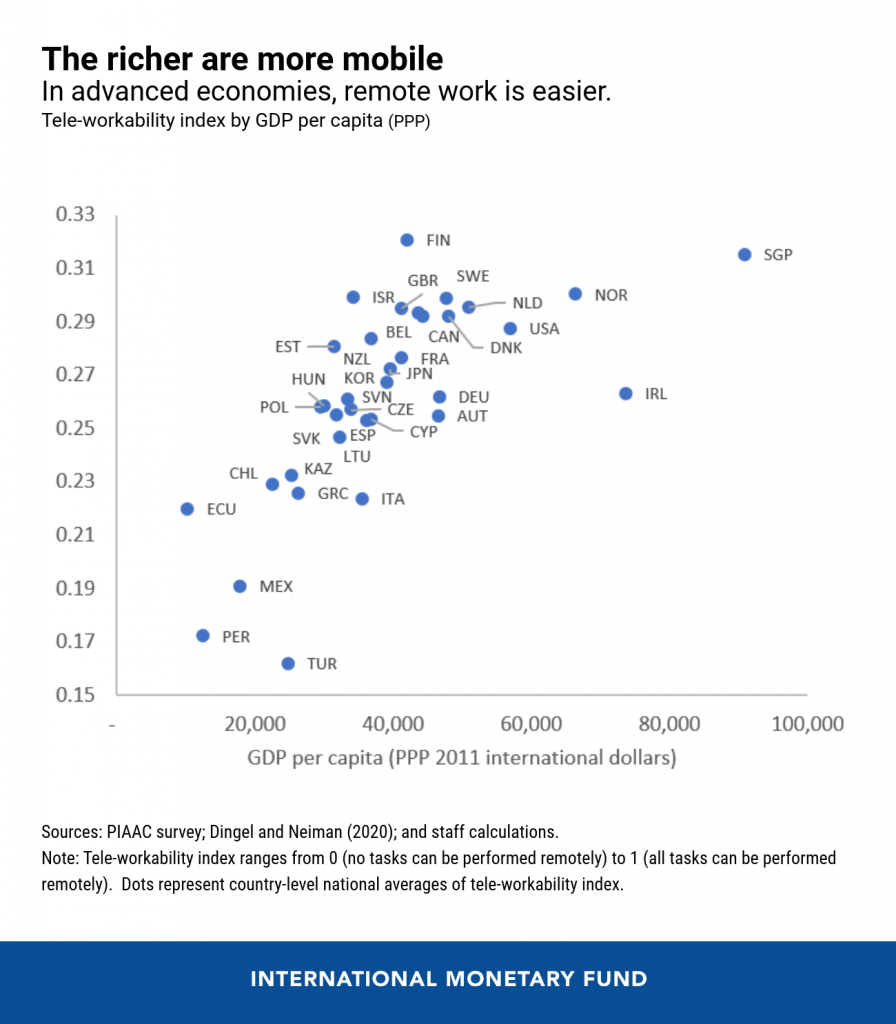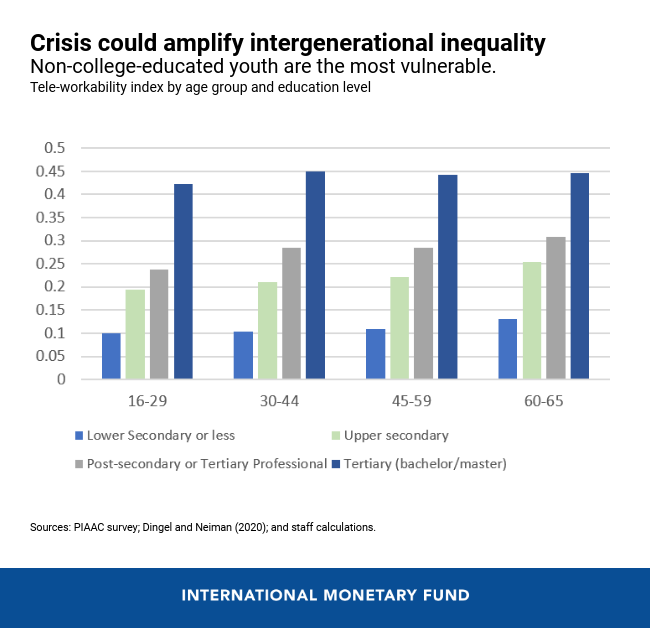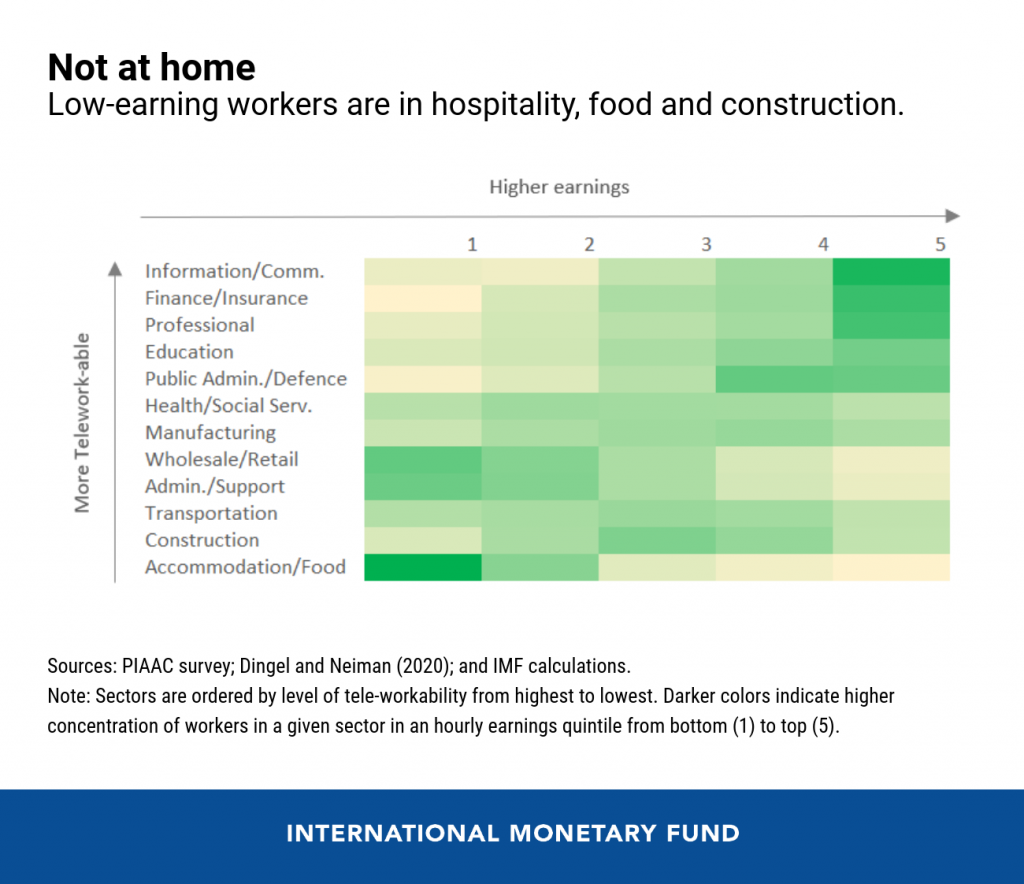عربي, 中文, Español, Français, 日本語, Português, Русский
The COVID-19 pandemic is devastating labor markets across the world. Tens of millions of workers lost their jobs, millions more out of the labor force altogether, and many occupations face an uncertain future. Social distancing measures threaten jobs requiring physical presence at the workplace or face-to-face interactions. Those unable to work remotely, unless deemed essential, face a significantly higher risk of reductions in hours or pay, temporary furloughs, or permanent layoffs. What types of jobs and workers are most at risk? Not surprisingly, the costs have fallen most heavily on those who are least able to bear them: the poor and the young in the lowest-paid jobs.
In a new paper, we investigate the feasibility to work from home in a large sample of advanced and emerging market economies. We estimate that nearly 100 million workers in 35 advanced and emerging countries (out of 189 IMF members) could be at high risk because they are unable to do their jobs remotely. This is equivalent to 15 percent of their workforce, on average. But there are important differences across countries and workers.
The nature of jobs in each country
Most studies measuring the feasibility of working from home follow job definitions used in the United States. But the same occupations in other countries may differ in the face-to-face interactions required, the technology intensity of the production process, or even access to digital infrastructure. To reflect that, the work-from-home feasibility index that we built uses the tasks actually performed within each country, according to surveys compiled by the OECD for 35 countries.
We found significant differences across countries even for the same occupations. It is much easier to telework in Norway and Singapore than in Turkey, Chile, Mexico, Ecuador, and Peru, simply because more than half the households in most emerging and developing countries don’t even have a computer at home.
Who is most vulnerable?
Overall, workers in food and accommodation, and wholesale and retail trade, are the hardest hit for having the least “teleworkable” jobs at all. That means more than 20 million people in our sample who work in these sectors are at the highest risk of losing their jobs. Yet some are more vulnerable than others:
-
Young workers and those without university education are significantly less likely to work remotely. This higher risk is consistent with the age profiles of workers in the sectors hardest hit by lockdowns and social distancing policies. Worryingly, this suggests that the crisis could amplify intergenerational inequality.
-
Women could be particularly hit hard, threatening to undo some of the gains in gender equality made in recent decades. This is because women are disproportionately concentrated in the hardest-hit sectors like food service and accommodation. In addition, women carry a heavier burden of child care and domestic chores, while market provision of these services has been disrupted.
-
Part-time workers and employees of small and medium-sized firms face greater risk of job loss. Workers in part-time work are often the first to be let go when economic conditions deteriorate, and the last to be hired when conditions improve. They are also less likely to have access to health care and the formal insurance channels that can help them weather the crisis. In developing economies, in particular, part-time workers and those in informal work face a dramatically higher risk of falling into poverty.

The impact on low-income and precariously-employed workers could be particularly severe, amplifying long-standing inequities in societies. Our finding—that workers at the bottom of the earnings distribution are least able to work remotely—is corroborated by recent unemployment data from the United States and other countries. The COVID-19 crisis will exacerbate income inequality.
To compound the effect, workers at the bottom of the income distribution are already disproportionately concentrated in the hardest-hit sectors like food and accommodation services, which are among those sectors least amenable to teleworking. Low-income workers are also more likely to live hand-to-mouth and have little financial buffers like savings and access to credit.
How to protect the most vulnerable?
The pandemic is likely to change how work is done in many sectors. Consumers may rely more on e-commerce, to the detriment of retail jobs; and may order more takeout, reducing the labor market for restaurant workers.
What can governments do? They can focus on assisting the affected workers and their families by broadening social insurance and safety nets to cushion against income and employment loss. Wage subsidies and public-works programs can help them regain their livelihoods during the recovery.
To reduce inequality and give people better prospects, governments need to strengthen education and training to better prepare workers for the jobs of the future. Lifelong learning also means bolstering access to schooling and skills training to help workers displaced by economic shocks like COVID-19.
This crisis has clearly shown that being able to get online was a crucial determinant to people’s ability to continue engaging in the workplace. Investing in digital infrastructure and closing the digital divide will allow disadvantaged groups to participate meaningfully in the future economy.






